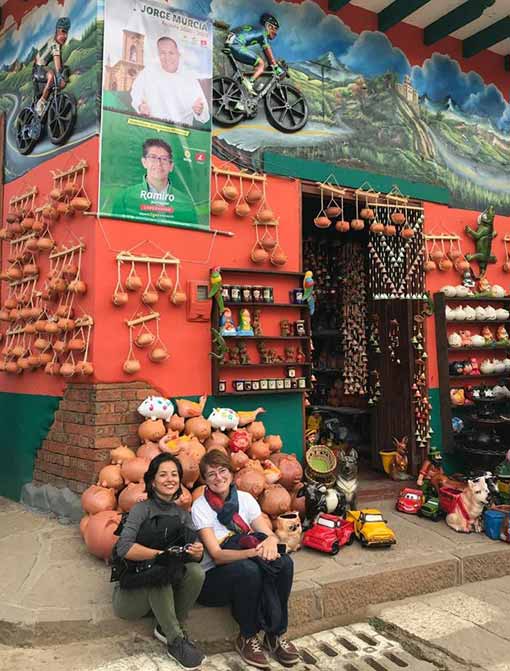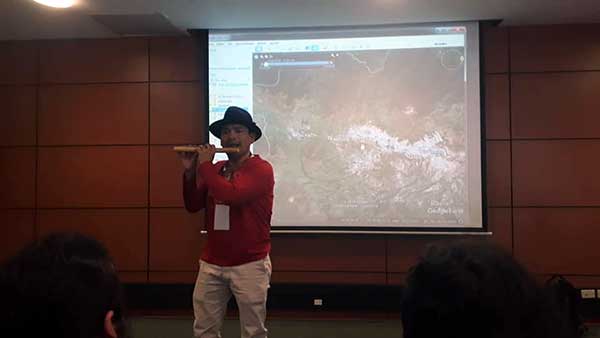By Ana María Alarcón Jiménez, Postdoctoral Researcher
During these past months, there have been a number of discussions in professional groups like the Society for Ethnomusicology and the American Musicological Society concerning the impact that the attendance to both national and international conferences has on climate change. Some of the suggestions made to minimize climate change included to increase telematic encounters as an alternative to flying and thus reduce carbon emissions. The proposal was also made of reducing the use of disposable materials including paper programs, flyers, and disposable plates and cups. Being an immigrant scholar who was born in Colombia, who studied both in the United States and Portugal, and who presently works in Spain, I often use Skype and WhatsApp to talk to my family and friends. Yet, regarding conferences, I am an advocate of non-virtual interpersonal contact. My past and very recent experience has shown me the great value of talking to people face to face. Therefore, I want to focus this blog post on a past conference, as a way to extend its timing and, perhaps, as a virtual attempt to dilute the Carbon Dioxide Emissions of my transatlantic travels by bringing its pastness into a wider present.
Returning
The 9th Art History Symposium Artes, paisajes y objetos sonoros del pasado (“Arts, Landscapes, and Sonic Objects from the Past”) took place at the University of the Andes, in Bogota, Colombia from September 25 to 27, 2019. It was organized by archaeologist Alexander Herrera and the Art History Department of the hosting institution. The Artsoundscapes project was represented by Margarita Díaz-Andreu and myself with two papers: “Rock Art, Music, and Schizophonia: Interdisciplinary Representations of the Yokuts Peoples’ Sonic Practices (San Joaquin valley, California, USA)” (by Ana-María Alarcón-Jiménez, Raquel Jiménez Pasalodos, Tommaso Mattioli, and Margarita Díaz-Andreu) and “The Soundscapes of Baja California South: Preliminary Results of the Acoustic Analysis of the Rock Art of the Gran Mural at the Santa Teresa Canyon” (by Margarita Díaz-Andreu, María Luz Gutiérrez Martínez, Tommaso Mattioli, Laura Coltofean, Mathieu Picas, César Villalobos, and Leslie Zubieta).
For me, the conference represented an opportunity to return to the country that I had left as a young woman. Now, coming back as a Doctor in Ethnomusicology, I was able to evidence in situ the advances that have taken place in my hometown with regards to the academic study of music. When I left in 2001, ethnomusicology and musicology had a small space in the undergraduate curricula of both public and private universities all over the country. Anyone willing to undertake graduate training in these disciplines had to either go abroad or accommodate into other, more established areas of study such as history or architecture. My 2019 meeting with ethno/musicology graduate and undergraduate students from different universities in Colombia at the above-mentioned Symposium, as well as with Colombian music researchers working in different national and international projects and institutions, drew a picture that clearly contrasted with my past experience. Colombian music scholars, as this Symposium showed me, have successfully contributed to open up a space for the advancement of music research within higher education institutions.

From left to right: Ana-María Alarcón-Jiménez and Margarita Díaz-Andreu in Ráquira, Boyacá, Colombia. A few days before the conference
The Conference Soundscapes
The Symposium at the University of the Andes took place simultaneously with a number of student demonstrations; these preceded the later national protests that overtook Colombia towards the end of November 2019. However, the soundscape of this academic encounter was undisturbed by the student marches and, it could be said, there was a split between these two simultaneous social manifestations. Within the conference, precisely, one of the most recurrent issues discussed was that of “soundscape”. The Symposium presenters mobilized this term across diverse geographical and historical boundaries. In most cases, the concept was used in reference to the meaning proposed by Canadian composer and music educator Raymond Murray Schafer in his The Soundscape: Our Sonic Environment and the Tuning of the World (1994). In this text, Schafer defined soundscape as “the sonic environment. Technically, any portion of the sonic environment regarded as a field for study (…)” (Schafer 1994, 274-275).
Even though the term has been criticized and re-elaborated to take into account both, the historical anti-pollution movements that shaped Schafer’s conceptualization of the word (Thompson 2002) and the need to include human perception and recording technologies as vectors that determine the extent of what a soundscape might entail (Feld 2015; Ingold 2008; Novak and Sakakeeny 2015; Samuels et al 2010), most mentions to soundscapes in the context of the Symposium did not make use of these later (and more recent) reflections.
Throughout the Symposium, the term “soundscape” consolidated as the glue that bound together a group of diverse scholars and students –working on music and sound-related practices from the Latin American hemisphere. There were archaeologists, music archaeologists, ethno/musicologists, geographers, biologists, museologists, music composers, music performers, and sound artists, among others. The two main geographical areas discussed were the Andes and the Mayan ancestral territories. In addition to soundscape, others topics dealt with during the Symposium included the organological and archaeological analysis of musical instruments from the Americas (see for instance Francisca Zalaquett’s work), indigenous sound studies (for example Campos Beltrán, Cabrera, and Reyes’ work), archaeoacoustics, music and sound aesthetics (Henry Stobart’s presentation), and the archaeology of musical gestures (Xavier Bellenger’s work). The Symposium opening and closing presentations, delivered by scholars Adje Both and Henry Stobart respectively, succeeded in highlighting the importance of developing empirically grounded studies based on archeological, historical, musicological but also on ethnographic research, and of implementing new technologies to improve the outreach and dissemination of Latin American music archaeology among both specialized and non-specialized audiences (see for instance Both’s project in Teotihuacan). Meeting, sharing time with, and listening to these academics during the Symposium made me feel connected to a vivid network of music-centered actions and ideas.
Final Reflections with Tayta Andrés Ayala
The Symposium at the University of the Andes closed with a meeting where presenters and assistants discussed the creation of a group to reflect on Latin American music archaeology. This conversation continued later on at the conference Music Archaeology of Latin America organized by scholars Henry Stobart, Bill Sillar, Dianne Scullin, and Manuel Arroyo-Kalinat at UCL in London. This latter encounter will probably materialize in the forthcoming creation of a new professional group. I am still thinking on some the ideas that both academic events planted, like seeds, in my head, including the importance of defining soundscape from a Latin American perspective and the challenges of developing interdisciplinary research with a variety of methodological approaches and timings. Finally, a last thing I would like to mention is the vivid impression made upon me by the participation in the Symposium in Colombia of Tayta Andrés Ayala, an indigenous researcher from the Quinatoa Ancestral Clan of Ecuador. Ayala’s interactive presentational style stood out from the overall delivery techniques used by other presenters. He handed out booklets to learn the Quechua language to audience members who answer his questions correctly. He brought in musical instruments and made use of them to emphasize his arguments, and he played a series of music compositions that he and the members of the artistic collective Sonidos Resonantes specifically made for the Symposium attendees. In his paper, Ayala made a series of interesting points that echoed the statements of other scholars at this academic gathering, specifically regarding the importance of advocating for a more open access for indigenous peoples to the musical instruments that are part of their cultural heritage and which are housed at different museum collections. Furthermore, Ayala proposed the idea of “hacking musical instruments” in collaboration with indigenous experts when archaeological and organological information was scant. The power of this idea was shown by Ayala himself during the visit payed by the Symposium presenters to the Ceramics Restauration Room of the Museo del Oro (Gold Museum) in Bogota, Colombia. In this room, which holds a series of pre-Hispanic objects from different indigenous groups and historical times, and surrounded by the museum restorers, Ayala interacted with different pieces being able to identify a couple of anthropomorph figures, proposing them as paired musical instruments, a statement that he backed up by identifying a possible mouthpiece as well as anatomically placed finger holes in the bodies of these figures.

Tayta Andrés Ayala during his presentation at the Symposium
